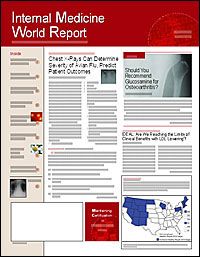Publication
Article
Internal Medicine World Report
Patients with Asthma Receiving Less-than-Ideal Care
Author(s):
From the American College of Allergy, Asthma & Immunology
ANAHEIM, Calif—A significant number of patients with severe asthma are still turning up in emergency ­departments on a regular basis, despite new treatments for helping them control their disease.
Data from a 3-year study of physicians who care for patients with severe asthma show that 20% to 25% of their patients still need urgent care from a physician or in the emergency department during any 3-month period.
“Even cared for by experts and re­ceiving state-of-the-art care, you would think the patients in the analysis would be doing quite well, but they aren’t,” said Michael Kaliner, MD, of George Washington School of Medicine, Wash­ington, DC. “It is surprising. We have better care than ever before, but we still have a long way to go, and we still need additional approaches.”
New results from the national Per­ceptions of Asthma Care survey, which were announced at the American College of Allergy, Asthma & Immunology (ACAAI) annual meeting, show that physicians believe that approximately 60% to 70% of emergency de­part­ment visits among their mild-to-moderate ­asthma patients, and 50% of such visits among their severe asthma patients, could have been prevented with better disease management.
“Given that in the last year there have been nearly 2 million asthma-related emergency department visits and approximately 5000 asthma-related deaths, these survey results are not surprising,” said Myron Zitt, MD, president of ACAAI. “We hope these results open a dialogue about the importance of asthma patients having a thorough asthma action plan, regular doctor visits, and the right treatments, regardless of severity.”
The survey showed that 59% of allergists and 43% of primary care physicians believed that increased used of antiinflammatory or “controller” medications (eg, in­haled corticosteroids and leuk­otrine inhibitors) would be effective in preventing unnecessary emergency de­partment visits and deaths among patients with asthma. More than half of the primary care physicians (56%) reported that better patient education on the use of short-acting bronchodilators, or “rescue inhaler” medications, would be another effective strategy for preventing unnecessary trips to the emergency department.
In addition, 59% of primary care physicians and more than 7 in 10 specialists surveyed (76% of allergists and 70% of pulmonologists) are unsatisfied with currently available treatments. More than 4 in 10 physicians who treat ­asthmatics, including nearly half of ­allergists (47%), would be interested in ­prescribing a new short-acting bronchodilator, according to the survey.
Results showed that physicians are managing the majority of their mild intermittent asthma patients (>80%) with only short-acting bronchodilators. Further­more, controller medications, such as inhaled corticosteroids, are still largely being reserved for patients with moderate-to-severe asthma.
Dr Zitt said the combination of poor asthma management coupled with the inadequate use and availability of medications may be leading to less-­than-ideal, and even dangerous, ­disease management.
The survey was conducted Sep­tember 9-19, 2005, among 306 physicians, including 156 primary care physicians, 55 allergists, and 95 pulmonologists.





